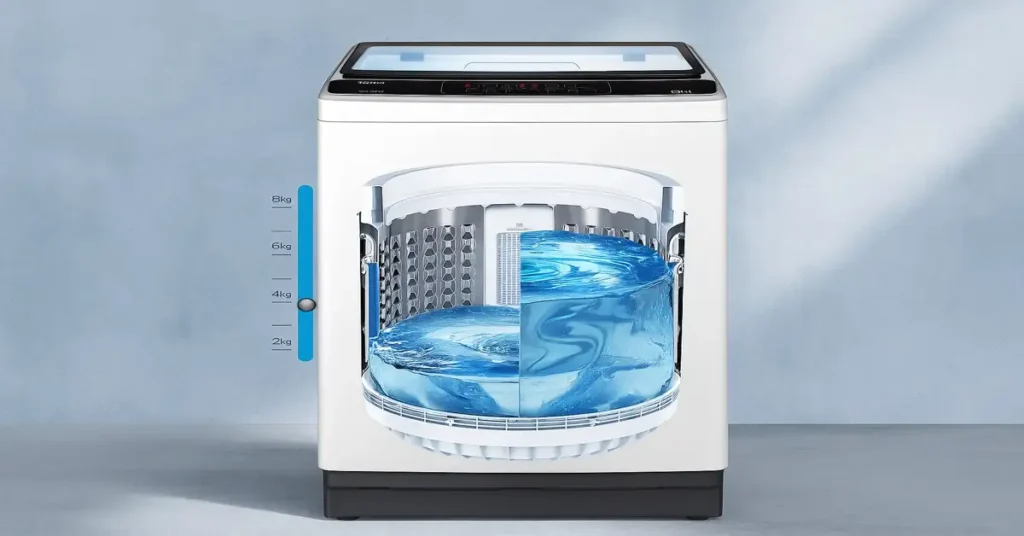If you have ever had the misfortune of having the automatic washing machine not drain while on the job, you would appreciate the endless frustration attached to it.
In this guide, I shall teach you an easy method on how to drain water from an automatic washing machine, drawing from my personal experience. I will also provide the fastest and safest ways to get your laundry going again-so you won’t risk damaging your precious machine.
Why Draining Your Washing Machine Matters
A clogged drain hose, blocked pump filter, or just a washer not draining upon completion of the wash cycle — manual water draining comes in handy in any of these cases.
It might save a huge repair bill, save your floors from water damage, and keep your machine running smoothly.
Also Read: How to Fix Washing Machine Tap
Step-by-Step: How to Drain Water from Automatic Washing Machine

Below is the procedure I use at home if my front-load or top-load washing machine doesn’t properly drain.
Step 1: Turn Off the Power
- Turn off the power to the washer, and unplug it from the electric socket.
- If one can, it is advisable to turn off the machine using the circuit breaker to minimize any risk of electric shock.
- Keep handy a towel and flat containers to collect the water.
Step 2: Locate the Drain Filter & Emergency Drain Tube
- In front-load fully automatic washing machines, the drain filter is usually located at the bottom front. Open the filter cover, and you will find the emergency drain tube.
- For top-load washing machines, the filter may not be available from the front. You may have to track the drain hose at the back and pull it out to drain the water.
- Always keep a bucket or flat container to collect the water ready before you mess with the filter or hose.
Step 3: Manually Drain the Water
- For front-load models: Remove the emergency drain hose, and then allow the water to flow into the container.
- For top-load models: Disconnect the main drain hose at the back, and the water will start flowing into the bucket.
- If water drains slowly, your drain hose is likely clogged – the first thing you will have to do is to clean it.
- Collect the water until the water inside the machine is completely drained.
Step 4: Clean the Pump Filter
- Open the drain hose or drain pipe to allow water to come out, then clean the pump filter (front-load) to rid it of lint, coins, and debris.
- To ensure that the washer will have proper drainage in future cycles.
Step 5: Restart the Unit
- Reconnect the drain hose and close the filter cover.
- Restart the unit by turning it off and then on again.
- Run a quick rinse/drain cycle to see if the problem is fixed.
Also Read: How to Use Automatic Washing Machine Step-by-Step
Quick Tips to Prevent Drainage Problems
| Problem | Prevention Tip |
|---|---|
| Clogged Drain Hose | Check monthly and clean. |
| Detergent Build-up | Reduce the amount of detergent used. |
| Unbalanced Load | Distribute clothes evenly before washing. |
| Foreign Objects | Check pockets before loading clothes. |
Extra Notes for Indian Households
- Again, if you have an LG top-load washing machine or a Samsung washing machine, practically the same procedure applies; only the user manual will specify exact filter locations.
- For frequent clogs, you might want a washing machine stand with which to elevate your washing machine, especially where water drainage is a problem.
- You may also shop for washing machines on Amazon with better drainage systems.
Also Read: How Many Clothes in 6kg Washing Machine?
FAQs
How to force a washing machine to drain water?
To force-drain your washing machine, turn off the power and locate the drain filter or hose, then manually let the water flow into a bucket. For LG washing machines, see the official LG support guide for the steps relating to your specific model.
How long does a drain cycle take?
On most washing machines, the drain cycle usually takes from 3 to 5 minutes, but it may be longer when the load is heavier or if the drain hose is partially blocked.
How to drain a washing machine mid-cycle?
Drop the wash midway by pressing pause the wash, powering it off, and turning the control to drain/spin mode or to use a manual drain hose, if it is present. Always make sure that the power supply is disconnected while dealing with water.
Can you end a wash cycle early?
The wash cycle can indeed be ended prematurely. After pressing the Start/Pause button, select Drain or Spin, so that water does not remain in the drum.
Which cycle drains a washing machine?
The Drain or Drain & Spin cycle serves to drain the water out of the drum. The equivalent functions on LG washing machines may be labeled simply as Spin or Rinse+Spin.
Final Thoughts
Learning methods of how to drain water from automatic washing machines remains a must-have skill in every Indian household. Whether manual draining needs to be performed under emergency circumstances, fixing a clogged pump, or the usage of an emergency drain tube are useful steps for saving one from costly repairs. Just keep in mind — turn off the power and work safely.
